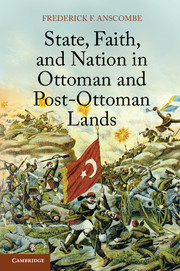Book contents
- Frontmatter
- Dedication
- Contents
- List of Maps and Images
- Acknowledgments
- Transliteration and Abbreviations
- Maps
- Introduction
- Part I The Ottoman Empire
- 1 State, Faith, Nation, and the Ottoman Empire
- 2 The Premodern Islamic State and Military Modernization
- 3 The Breaking of the Premodern Islamic State
- 4 The Reconstructed Muslim State
- 5 End of Empire
- Part II From Ottoman to Post-Ottoman States
- Part III Contemporary Post-Ottoman States
- Conclusion State, Faith, and Nation
- Bibliography
- Index
- References
3 - The Breaking of the Premodern Islamic State
Published online by Cambridge University Press: 05 June 2014
- Frontmatter
- Dedication
- Contents
- List of Maps and Images
- Acknowledgments
- Transliteration and Abbreviations
- Maps
- Introduction
- Part I The Ottoman Empire
- 1 State, Faith, Nation, and the Ottoman Empire
- 2 The Premodern Islamic State and Military Modernization
- 3 The Breaking of the Premodern Islamic State
- 4 The Reconstructed Muslim State
- 5 End of Empire
- Part II From Ottoman to Post-Ottoman States
- Part III Contemporary Post-Ottoman States
- Conclusion State, Faith, and Nation
- Bibliography
- Index
- References
Summary
Historians commonly treat the reigns of Selim III and Mahmud II as a practically seamless whole, but despite some continuities, Mahmud ruled essentially in opposition to what he had seen of Selim’s practice. Where Selim’s attempts at state strengthening stirred resistance from the established Ottoman military, Mahmud’s disdain for the limits on sultanic action that Selim had accepted spread disaffection and rebellion to a much wider population. Unlike Selim’s, Mahmud’s method of rule was to break extant systems, or at least to cripple them to ensure their subservience; his efforts to topple any power not obviously dependent upon his court created turmoil in both center and provinces, where his actions otherwise had small effect beyond his clients’ seizing a greater part of the wealth of provincial notables while leaving to them, or their families, much of their local influence. In the manner and methods of provincial administration, he changed little on a systematic basis, and his rule brought the empire to the point of collapse. Mahmud felt bound to observe few rules in his campaign to remake the empire into an entity better able to defend itself against its external enemies; in so doing, he alienated subjects who still held to the ideology legitimating Ottoman rule and did not share his conviction that he need not dispense, but rather could dispense with, justice. His decisions also accentuated Muslim ethnic identity by closing to Albanians, Bosnians, Kurds, and Arabs the ranks of the army he founded to replace the janissaries, a move that gave a lasting “Turkish” flavor to the empire. In another move that would prove more clearly damaging in future, he also surrendered much of Istanbul’s long-treasured authority over commerce by concluding an ill-considered trade convention with Britain in 1838. Selim III’s overthrow may have marked one of the low points in Ottoman imperial politics, but Mahmud’s survival on the throne for thirty-one years did not mark an upturn in the empire’s fortunes: at his death, he faced dethronement not by rioters but by a better-organized and cleverer underling, Mehmed (Muhammad) Ali, governor of Egypt. His successor, Abdülmecid I, had to issue a proclamation of intent not to rule as Mahmud had done in order to reconsolidate support for the throne among Muslim and non-Muslim subjects alike. Unlike the Deed of Agreement, this proclamation turned out to be lastingly significant.
- Type
- Chapter
- Information
- Publisher: Cambridge University PressPrint publication year: 2014



